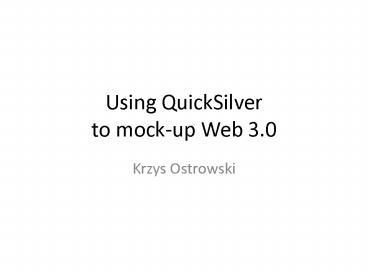Using QuickSilver to mockup Web 3.0 - PowerPoint PPT Presentation
Title:
Using QuickSilver to mockup Web 3.0
Description:
http://msdn2.microsoft.com/en-us/xna/bb245766.aspx. MSDN Documentation (three examples) http://msdn2.microsoft.com/en-us/library/bb203894.aspx ... – PowerPoint PPT presentation
Number of Views:93
Avg rating:3.0/5.0
Title: Using QuickSilver to mockup Web 3.0
1
Using QuickSilver to mock-up Web 3.0
- Krzys Ostrowski
2
Introduction
3
(No Transcript)
4
BAD
5
(No Transcript)
6
BAD
7
(No Transcript)
8
(No Transcript)
9
(No Transcript)
10
(No Transcript)
11
(No Transcript)
12
(No Transcript)
13
Architecture
14
(No Transcript)
15
(No Transcript)
16
(No Transcript)
17
(No Transcript)
18
(No Transcript)
19
Tools
20
Development Environment
- Microsoft Visual Studio 2005 Express
- (supports XNA Framework Game Studio Express)
- XNA Project types
- Implements the content pipeline
- Microsoft Visual Studio 2005 Professional
- (support only the XNA Framework)
- Version control,
- Debugging multithreaded applications, etc.
21
content
loading content
22
Coding
23
How to access the functionalityprovided by XNA,
QMS etc.
24
(No Transcript)
25
(No Transcript)
26
(No Transcript)
27
(No Transcript)
28
Add a pre-build event to manually
copy QuickSilver_0.dll, You can also copy over
graphical content here
29
Where to write your own code
30
namespace MyGameClient public partial
class Form1 Form public Form1()
InitializeComponent()
gamethread new Thread(new
ThreadStart(ThreadCallback))
gamethread.Start()
31
public partial class Form1 Form
private void ClosingCallback( object
sender, FormClosingEventArgs e)
32
(No Transcript)
33
When does your code run?
34
Threads
- Game Thread
- Rendering graphics
- Respond to mouse/keyboard
- Windows Forms Thread
- Rendering Forms
- Respond to mouse/keyboard
- QSM Thread (inside QSM)
- Network communication
- Your own threads?
- Your background processing etc.
game new MyGame() game.Run()
Application.Run( new Form1())
client QS.CMS.Framework2.Client.Create()
35
Your Code
- Your own threads
- Callbacks from Windows Forms (GUI Thread)
- Mouse, keyboard etc.
- Callbacks from Game (Game Thread)
- Update(GameTime gameTime)
- Draw(GameTime gameTime)
- Callbacks from QSM (QSM Thread)
- When packets are received, sent, acked etc.
- Must do minimum work and leave!
36
How to use QSM
37
Launching QSM client
- using QS.CMS.Framework2
- ClientConfiguration configuration
- new ClientConfiguration(
- 192.168.0.0/24, 10000,
192.168.0.100) - configuration.Verbose true
- IClient client Client.Create(configuration)
select the NIC
port number
GMS address
38
Joining a QSM group
- IGroup group client.Open(
- new QS.CMS.Base3.GroupID(groupid),
GroupOptions.FastCallbacks)
numeric identifier
how QSM interacts with your code
39
Receiving from a group
- group.OnReceive
- new IncomingCallback(ReceiveCallback)
- private void ReceiveCallback(
- QS.CMS.Base3.InstanceID sender,
QS.CMS.Base3.ISerializable message) - Message m (Message) message
called on receive
your class
40
Sending to a group (1)
- group.BufferedChannel.Send(new Message())
you can send this way from any thread
uses internal buffer to store messages you are
sending
41
Sending to a group (2a)
42
Sending to a group (2b)
- group.ScheduleSend(
- new OutgoingCallback(SendCallback))
- private void SendCallback(
- IChannel channel,
- uint maxsend,
- out bool hasmore)
- channel.Send(new Message())
- hasmore false
unbuffered
max messages
keep sending?
43
Serialization
- Built-in XML
- Flexible, easy to use
- Slow
- Space-consuming
- Built-in binary
- Useless
- QSM
- Fast, supports scatter-gather I/O
- Takes getting used to
44
traditional serialization
45
scatter-gather serialization
46
serialization in QSM
47
Anatomy of a serializable class (1)
(1)
- QS.CMS.Base2.ClassID(Message.ClassID)
- public sealed class Message QS.CMS.Base3.ISerial
izable - public const ushort ClassID
- (ushort) (QS.ClassID.UserMin 100)
- public Message()
(3)
(2)
(4)
48
Anatomy of a serializable class (2)
(6)
- unsafe QS.CMS.Base3.SerializableInfo
- QS.CMS.Base3.ISerializable.SerializableInfo
- get
- return
- new QS.CMS.Base3.SerializableInfo(
- ClassID, sizeof(uint) 2
sizeof(float))
(5)
class identifier
header size
49
(No Transcript)
50
Anatomy of a serializable class (3)
- unsafe void QS.CMS.Base3.ISerializable.SerializeTo
( - ref QS.Fx.Base.ConsumableBlock header,
- ref IListltQS.Fx.Base.Blockgt data)
- fixed (byte arrayptr header.Array)
- byte headerptr arrayptr
header.Offset - ((uint)headerptr) playerid
- ((float)(headerptr sizeof(uint)))
x - ((float)(headerptr sizeof(uint)
sizeof(float))) y - header.consume(sizeof(uint) 2
sizeof(float))
here you can copy
(7)
append your buffers here
(8)
(9)
(10)
51
How to use WCF
52
shared class library
reference WCF DLLs
reference your class lib from client and server
53
- using System.ServiceModel
- namespace MyGameLib
- ServiceContract
- public interface IMyGameServer
- OperationContract
- void JoinTheGame(string myname, byte
mypicture, out uint myid, out uint
groupid) - OperationContract
- void GetPlayerInfo(uint playerid,
- out string playername, out byte
playerpicture)
54
- ServiceBehavior(
- InstanceContextMode InstanceContextMode.Sing
le) - public partial class Form1
- Form, MyGameLib.IMyGameServer
- public Form1(string subnet)
- servicehost new ServiceHost(this)
- servicehost.AddServiceEndpoint(
- typeof(MyGameLib.IMyGameServer),
- new WSHttpBinding(),
- "http//" Dns.GetHostName()
"60000") - servicehost.Open()
55
- ChannelFactoryltMyGameLib.IMyGameServergt
servicefactory - new ChannelFactoryltMyGameLib.IMyGameServer
gt( - new WSHttpBinding(),
- new EndpointAddress(
- "http//" serveraddress
"60000")) - IMyGameServer gameserver
- servicefactory.CreateChannel()
- gameserver.JoinTheGame(
- playername, picturebytes, out myid, out
groupid)
56
How to use XNA
57
- private Player CreatePlayer(
- uint id, string name, byte picture,
- Vector2 position)
- Player player new Player(,
- new SpriteBatch(graphics.GraphicsDevice),
- Texture2D.FromFile(graphics.GraphicsDevice
, - new MemoryStream(picture)),
- )
58
- protected override void Draw(GameTime gameTime)
- graphics.GraphicsDevice.Clear(Color.C
ornflowerBlue) - foreach (Player player in players.Values)
- player.sprite.Begin(SpriteBlendMode.AlphaB
lend) - player.sprite.Draw(
- player.texture, player.position,
Color.White) - player.sprite.End()
- base.Draw(gameTime)
59
How to abuse QSM
60
(No Transcript)
61
References
62
Software (1)
- Visual Studio 2005 Professional EditionMSDNAA
- Visual Studio 2005 Express Editionhttp//msdn.mi
crosoft.com/vstudio/express/ - XNA Framework, XNA Game Studio Expresshttp//msdn
2.microsoft.com/en-us/xna/ - OtherSee the tutorial for details (URL on next
page)
63
Software (2)
- QSM
- The QUickSilver Project webpagehttp//www.cs.corn
ell.edu/projects/quicksilver/QSM/index.htm - Download the latest distribution(0.12 as of the
time of writing this presentation) - Report bugs to Krzys
- krzys_at_cs.cornell.edu
- Remember to include logs (see the tutorial for
details)
64
Tutorials (1)
- Video Tutorials on MSDNhttp//msdn2.microsoft.com
/en-us/xna/bb245766.aspx - MSDN Documentation (three examples)
- http//msdn2.microsoft.com/en-us/library/bb203894
.aspx(you can find this content also in your
local help documentation installed with XNA)
65
Tutorials (2)
- QSM Tutorialhttp//www.cs.cornell.edu/projects/q
uicksilver/QSM/tutorial/tutorial.html - QSM APIhttp//www.cs.cornell.edu/projects/quicks
ilver/QSM/api/ - QSM Users Guidehttp//www.cs.cornell.edu/projec
ts/quicksilver/QSM/users_guide.htm
66
Discussion































